|
The Ten Costliest and Bloodiest Battles of the American
Civil War
Estimated Total Casualties (killed,
wounded, missing, and captured)
| Civil War Battles with most Killed and Casualties |
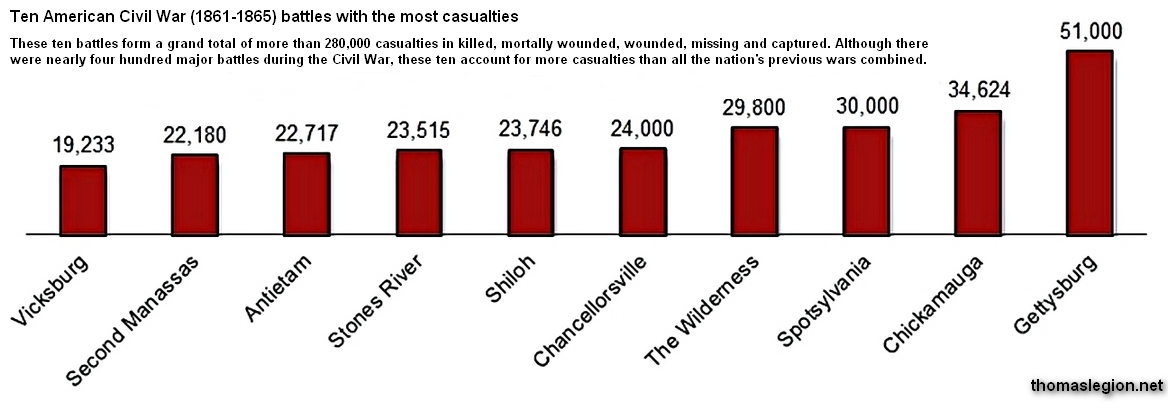
|
| Ten Deadliest Civil War Battles with most Casualties and Killed |
Top Ten Civil War Battles in most Killed, Mortally Wounded, and Casualties
| Civil War Killed, Wounded, and Missing |
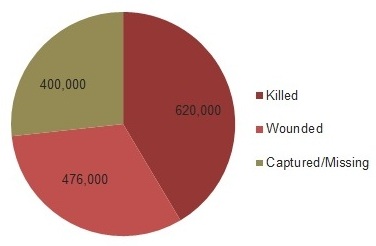
|
| Civil War Killed, Wounded, and Missing |
The deadly tally of the American Civil War (1861-1865) was an estimated 620,000 in total
killed, which was 2% of the total U.S. population. To compare the percentage of deaths
with the present-day U.S. population, it is equal to 6,000,000 killed. The majority of casualties and deaths
(not "killed") in the Civil War were the result of non-combat-related disease,
and for every soldier killed as a consequence of battle, two died of disease. The ten battles of the Civil War that
sustained the most casualties, collectively totaled nearly 300,000 in killed and wounded, which was more than the total
casualties from all of the nation's previous wars combined. Although casualties included fatalities, fatalities did not include
all casualties.
Casualties were
defined as soldiers who were unaccounted for or unavailable for service. Casualties included killed in action, mortally
wounded, wounded, missing, died of disease, died as a prisoner-of-war, died of causes other than battle, captured, and deserted.
On the other hand, fatalities only included soldiers who were killed in action, mortally wounded, and died of
disease or from other causes. Civil War statisticians of the era had a strict application of the words, killed,
died, dead, and deaths. Fatal is any action causing death. So if it's a fatality, it's death, if it is not fatal then it is
a casualty. Some however have erroneously interchanged casualty with fatality. Acclaimed Civil War statisticians
Fox and Dyer both applied similar metrics, and each applied one such metric cautiously while
striving to ascertain the difficult battle casualties known as missing-in-action, because often the missing soldier was discovered as
a prisoner-of-war or deserter, or was separated from his unit during the malaise, and at times was located dead on
the battlefield. The Union's final adjusted casualty tabulations for the many battles of the Civil War, as indicated
in the Official Records of the Union and Confederate Armies, were tallied and
sealed upon the cessation of hostilities. While Washington greatly reduced the
nation's military when the war ended in 1865, it also expressed that all military persons declared as
missing-in-action to hereinafter be considered as killed-in-action, and it was a necessary move for the widow desiring
to collect the much needed pension of her late husband. Because efforts were abandoned to obtain an accounting of the
missing-in-action, a large numerical void had remained, causing both statisticians to concede in the 1880s that,
with abstract totals, the missing soldiers should henceforth be considered as killed-in-action, as the United
States government had stated in 1865 with Union victory. See also Total Civil War killed and dead by category for
each Union and Confederate state.
| Dead Soldiers' Remains at Cold Harbor Battlefield |
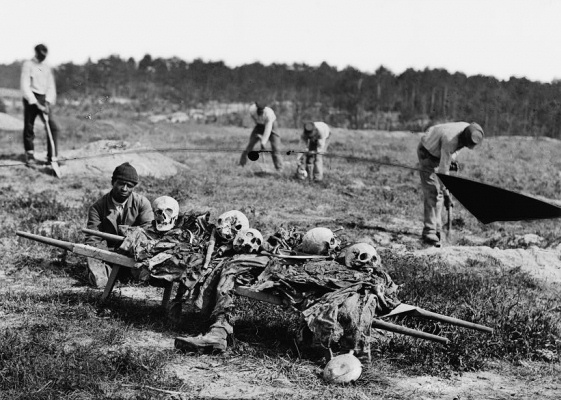
|
| The Casualties of Civil War |
| Ten Civil War Battles with Most Killed and Totals |
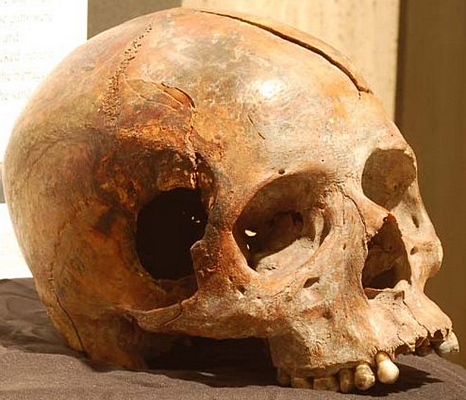
|
| Result of a Civil War |
While most soldiers died primarily of disease during the Civil War, the
second cause of mortality was battle related, from various wounds sustained, such as the headshot,
as viewed above, caused by the rare impact of a single iron canister ball, which had been fired from a nearby 12-pounder field
howitzer. This skull was discovered in 1876 on Morris Island, South Carolina, near the site of Battery Wagner, a powerful
earthwork fort that had protected the entrance to Charleston Harbor during the Civil War. The skull belonged to a man of African
descent—a soldier of the famous 54th Massachusetts Volunteers, which had led the assault on Wagner on the night of July
18, 1863. Of approximately 600 men who made the charge, 256 were killed, wounded, or missing. From the size of the wound,
and the remains of the projectile itself, it can be determined what type of munition hit this man: an iron canister ball from
one of two 12-pounder field howitzers known to have been used in the repulse of that attack. The 54th Massachusetts Volunteers
was not the first black regiment in the Civil War, nor was it the first to fight. However, it was the first black regiment
raised entirely of free men enrolled on exactly the same footing as white troops and the first to engage in a major action
well-covered by the national press. Its gallant conduct in the doomed assault on Battery Wagner, at Charleston, South Carolina,
on July 18, 1863, electrified the nation and proved once and for all that the black man, given the opportunity, could learn
the soldier’s trade, and fight as well as any white man.
| Most Civil War Battle Deaths and Killed in Action |
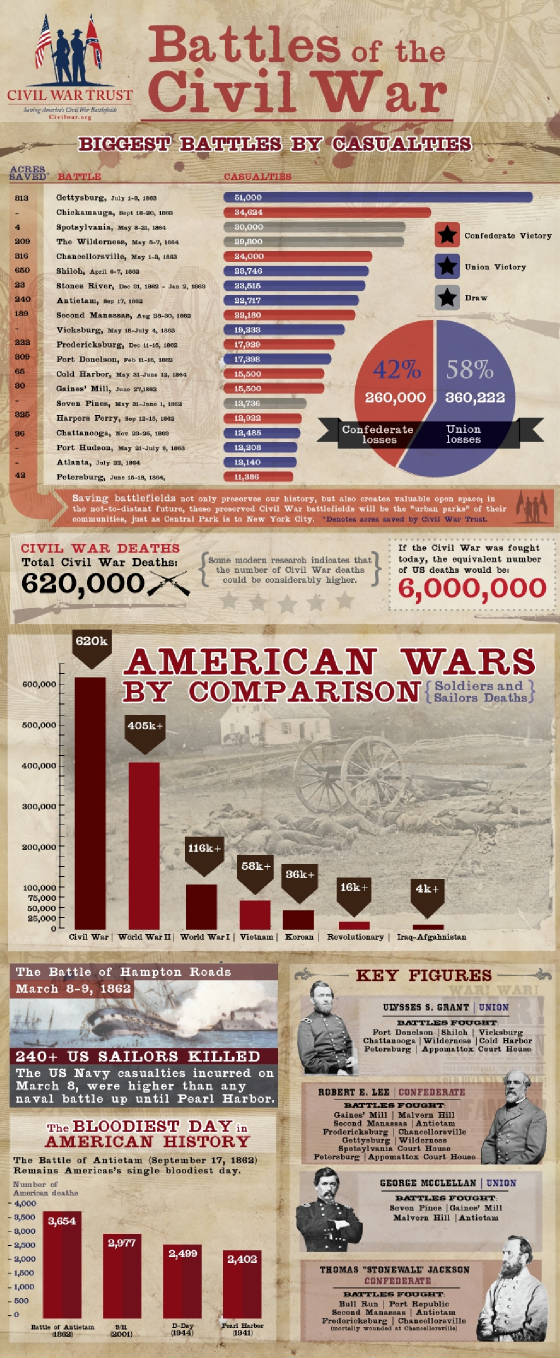
|
| Civil War Battles with Most in Killed and in Casualties |
Date: July 1-3, 1863
Location: Pennsylvania
Confederate Commander: Robert E. LeeUnion Commander: George G. Meade
Confederate Forces Engaged:
75,054
Union Forces Engaged: 83,289
Winner: Union
Casualties: 51,000
(23,000 Union and 28,000 Confederate)**
--------------------------------------------------------------------
Location: Georgia
Confederate Commander: Braxton Bragg
Union Commander: William Rosecrans
Confederate Forces
Engaged: 66,326
Union Forces Engaged: 58,222
Winner: Confederacy
Casualties: 34,624 (16,170 Union and 18,454
Confederate)**
--------------------------------------------------------------------------------
#3
Location: Virginia
Confederate Commander:
Robert E. Lee
Union Commander: Ulysses S. Grant
Confederate Forces Engaged: 52,000
Union Forces Engaged: 100,000
Winner:
Confederacy
Casualties: 30,000 (18,000 Union and 12,000 Confederate)**
--------------------------------------------------------------------------------
#4
Location: Virginia
Confederate Commander: Robert E. Lee
Union Commander: Ulysses S. Grant
Confederate Forces Engaged: 61,025
Union Forces Engaged: 101,895
Winner: Inconclusive
Casualties: 29,800 (18,400
Union and 11,400 Confederate)**
Note: Casualty sources vary greatly for Wilderness
--------------------------------------------------------------------------------
#5
Location: Virginia
Confederate Commander: Robert E. Lee
Union Commander: Joseph Hooker
Confederate Forces Engaged: 57,352
Union Forces Engaged: 97,382
Winner: Confederacy
Casualties: 24,000
(14,000 Union and 10,000 Confederate)**
Note: Total casualties exclude Marye's Heights and Salem Church
--------------------------------------------------------------------------------
#6
Location: Tennessee
Confederate Commander: Albert Sidney Johnston and P. G. T. Beauregard
Union Commander: Ulysses S. Grant
Confederate Forces Engaged: 44,968
Union Forces Engaged: 65,085
Winner:
Union
Casualties: 23,746 (13,047 Union and 10,699 Confederate)**
--------------------------------------------------------------------------------
Location: Tennessee
Confederate Commander: Braxton Bragg
Union Commander: William S. Rosecrans
Confederate Forces Engaged: 37,739
Union Forces Engaged: 41,400
Winner: Union
Casualties: 23,515 (13,249 Union
and 10,266 Confederate)**
| Union and Confederate Civil War Battle Deaths |
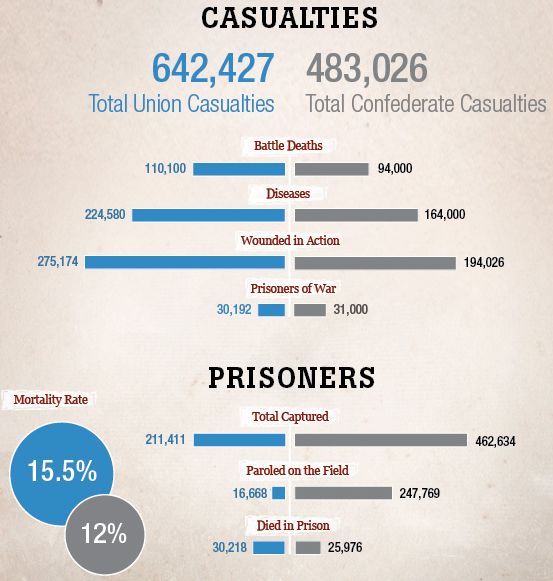
|
| Most Civil War Battle Casualties by Killed, Died, Deaths |
--------------------------------------------------------------------------------
#8
Location: Maryland
Confederate Commander: Robert E. Lee
Union Commander: George B. McClellan
Confederate Forces Engaged: 51,844
Union Forces Engaged: 75,316
Winner: Inconclusive
Casualties: 23,100 (12,400
Union and 10,700 Confederate)**
Note: Total casualties exclude the Battle of South Mountain.
Many, however, include the Battle of South Mountain which would add an additional 4,500 casualties
--------------------------------------------------------------------------------
#9
Location: Virginia
Confederate Commander: Robert E. Lee
Union Commander: John Pope
Confederate
Forces Engaged: 48,527
Union Forces Engaged: 75,696
Winner: Confederacy
Casualties: 22,180 (13,830 Union and 8,350
Confederate)**
--------------------------------------------------------------------------------
Location: MississippiConfederate Commander: John C. Pemberton
Union Commander: Ulysses
S. Grant
Confederate Forces Engaged: Army of Vicksburg
Union Forces Engaged: Army of the Tennessee
Winner: Union
Casualties: 19,233 (10,142 Union and 9,091 Confederate)**
Note: Total casualties exclude Confederate parolees
*A skirmish is considered a brisk or minor encounter between small
bodies of troops, especially advanced or outlying detachments of opposing armies. Example: There were several skirmishes prior
to the Battle of Gettysburg.
A battle or engagement is a prolonged and general conflict
pursued to a definite decision between large, organized armed forces. Example: Battle of Chancellorsville.
An action can be a battle or a skirmish. Example: There were several
actions or battles during the Gettysburg Campaign.
The term siege is the besetting of a fortified place by an army
to compel surrender. A continued attempt to gain possession. Example: Battle of Vicksburg was actually a siege with the objective
to compel the Confederate army to surrender.
The term military campaign applies to large scale, long duration,
significant military strategy plan incorporating a series of inter-related military operations or battles forming a distinct
part of a larger conflict often called a war. Example: Overland Campaign.
**Figures only include total battle casualties and exclude total casualties
for the respective campaign. Individuals should note that campaigns often involved several battles over prolonged periods.
All casualty figures are courtesy National Park Service.
(Related reading below.)
Sources: National Park Service; Civil War Trust at civilwar.org; Library
of Congress; National Archives; Official Records of the War of the Rebellion.
Recommended Reading:
Fields of Honor: Pivotal Battles of the Civil War,
by Edwin C. Bearss (Author), James McPherson (Introduction). Description: Bearss,
a former chief historian of the National Parks Service and internationally recognized American Civil War historian, chronicles
14 crucial battles, including Fort Sumter, Shiloh, Antietam, Gettysburg, Vicksburg, Chattanooga, Sherman's march through the
Carolinas, and Appomattox--the battles ranging between 1861 and 1865; included is an introductory chapter describing John
Brown's raid in October 1859. Bearss describes the
terrain, tactics, strategies, personalities, the soldiers and the commanders. (He personalizes the generals and politicians,
sergeants and privates.) Continued below...
The text is augmented by 80 black-and-white photographs and 19 maps. It
is like touring the battlefields without leaving home. A must for every one of America's countless Civil War buffs,
this major work will stand as an important reference and enduring legacy of a great historian for generations to come. "This
stout volume covers not only the pivotal American Civil War battles, but also the bloodiest, costliest, and deadliest battles." Also
available in hardcover: Fields of Honor: Pivotal Battles of the Civil War . .
Recommended Reading:
The Civil War Battlefield Guide: The Definitive Guide, Completely Revised, with New Maps
and More Than 300 Additional Battles (Second Edition) (Hardcover). Description: This new edition of the definitive guide to Civil War battlefields is really a completely
new book. While the first edition covered 60 major battlefields, from Fort Sumter to Appomattox, the second covers all of the 384 designated as the "principal battlefields" in the American Civil War Sites Advisory Commission
Report. As in the first edition, the essays are authoritative and concise, written by such leading Civil War
historians as James M. McPherson, Stephen W. Sears, Edwin C. Bearss, James I. Robinson, Jr., and Gary W. Gallager. Continued
below...
The second edition also features 83 new four-color maps covering the most important battles. The Civil War
Battlefield Guide is an essential reference for anyone interested in the Civil War. "Reading this book is like being
at the bloodiest battles of the war..."
Recommended Reading: This Republic of Suffering:
Death and the American Civil War. Publishers Weekly: Battle is the dramatic centerpiece of Civil War history;
this penetrating study looks instead at the somber aftermath. Historian Faust (Mothers of Invention) notes that the Civil
War introduced America to death on an
unprecedented scale and of an unnatural kind—grisly, random and often ending in an unmarked grave far from home. Continued
below...
She surveys
the many ways the Civil War generation coped with the trauma: the concept of the Good Death—conscious, composed and
at peace with God; the rise of the embalming industry; the sad attempts of the bereaved to get confirmation of a soldier's
death, sometimes years after war's end; the swelling national movement to recover soldiers' remains and give them decent burials;
the intellectual quest to find meaning—or its absence—in the war's carnage. In the process, she contends, the
nation invented the modern culture of reverence for military death and used the fallen to elaborate its new concern for individual
rights. Faust exhumes a wealth of material—condolence letters, funeral sermons, ads for mourning dresses, poems and
stories from Civil War–era writers—to flesh out her lucid account. The result is an insightful, often moving portrait
of a people torn by grief.
Recommended Reading: Gangrene and Glory:
Medical Care during the American Civil War (University
of Illinois Press). Description: Gangrene and Glory covers practically every aspect of the 'medical related issues' in the Civil War and it illuminates the key players
in the development and advancement of medicine and medical treatment. Regarding the numerous diseases and surgical procedures,
Author Frank Freemon discusses what transpired both on and off the battlefield. Continued below...
The Journal of the American Medical Association states: “In
Freemon's vivid account, one almost sees the pus, putrefaction, blood, and maggots and . . . the unbearable pain and suffering.”
Interesting historical accounts, statistical data, and pictures enhance this book. This research is not
limited to the Civil War buff, it is a must read for the individual interested in medicine, medical procedures and surgery,
as well as some of the pioneers--the surgeons that foreshadowed our modern medicine.
Editor's Choice: The Civil War - A Film by Ken Burns. Review: The
Civil War - A Film by Ken Burns is the most successful public-television miniseries in American history. The 11-hour Civil War didn't just captivate a nation,
reteaching to us our history in narrative terms; it actually also invented a new film language taken from its creator. When
people describe documentaries using the "Ken Burns approach," its style is understood: voice-over narrators reading letters
and documents dramatically and stating the writer's name at their conclusion, fresh live footage of places juxtaposed with
still images (photographs, paintings, maps, prints), anecdotal interviews, and romantic musical scores taken from the era
he depicts. Continued below...
The Civil War uses all of these devices to evoke atmosphere and resurrect an event that many knew
only from stale history books. While Burns is a historian, a researcher, and a documentarian, he's above all a gifted storyteller,
and it's his narrative powers that give this chronicle its beauty, overwhelming emotion, and devastating horror. Using the
words of old letters, eloquently read by a variety of celebrities, the stories of historians like Shelby Foote and rare, stained
photos, Burns allows us not only to relearn and finally understand our history, but also to feel and experience it. "Hailed
as a film masterpiece and landmark in historical storytelling." "[S]hould be a requirement for every
student."
|

